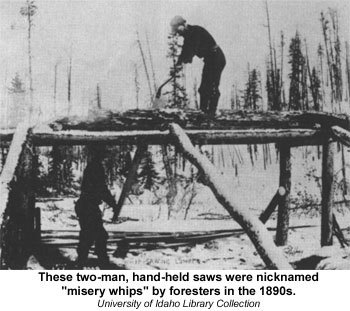Building Camp DuBois
Lewis and Clark spent most of the month of December, 1803 building their winter headquarters at the mouth of the Wood River, which was located at the confluence of the Mississippi and Missouri Rivers. The land belonged to Nicholas Jarrot, who lent it to the Corps of Discovery for the five months they were in Illinois. Several drawings exist for plans of Camp DuBois in Clark's field notes. Although splashed by an ink stain, this one shows the orientation, placement, and sizes of the cabins and fortifications. See Clark's sketch of the Camp DuBois area in his journal at the Yale Beinecke Library.
Most frontier huts were one or two rooms with a stone floor, a stone chimney, and a door. A loft was built for sleeping. The walls were made by stacking logs that had notches cut in each end to overlap at the corners. The cracks between the logs were filled with bark, twigs, and mud.
On December 13, the men began to clear the land and cut the logs for the huts. On the 20th, Clark borrowed one of the delivery wagons to haul freshly cut logs to the building site. Some of the men were able to move into a few huts. On the 23rd, Clark sent for a team of horses to help the men carry more logs. On the 23rd, new recruits arrived and they were tasked with building their huts. By the 24th, most of the huts had been roofed. Clark mentioned that he helped build a chimney, probably with river rocks.

Two handed whipsaw being used to saw a log lengthwise.
Copyright, University of Idaho
On the 17th, Lewis wrote Clark that through William Morrison, he had heard about someone nearby with a whipsaw, and would try to borrow it. He suggested that two of the newly arrived recruits be used to do the sawing. One of the new men was a house-joiner. On the 26th, the men began sawing with the whipsaw, which had a broad blade with large saw teeth. Two men would pull in turn as the saw cut its way down a log to form planks for rafters, floorboards, or doorframes. Mentioned in the field notes were axes and flat saws. Few other tools were used to build frontier huts or cabins. Tools were scarce, expensive, or homemade. Nails did not exist; pegs or tight joints held wood pieces together.
On December 30, Clark had finished his hut and moved in. The huts were not insulated, and therefore were very cold throughout the winter. On January 4, Clark mentioned in his notes that the temperature at 4 p.m. in a warm room was 20 degrees above zero; the temperature outdoors was 20 below zero.